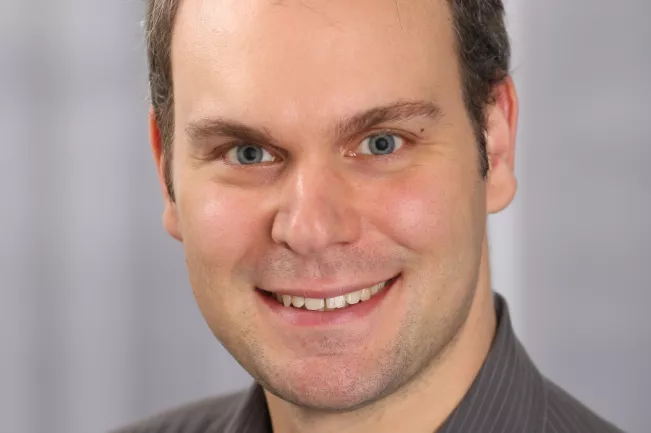Communications and Marketing | Alumni Office

Oliver Schwaneberg, Computer Science (M.Sc.)

One metre further. Just one metre further on, everything worked as planned. But the sensor simply wouldn't work. Very annoying - after all, the venue was the 2009 Hanover Fair, which Oliver Schwaneberg had travelled to together with two university professors, computer scientist Norbert Jung and Dietmar Reinert from the Institute for Occupational Safety and Health. The three scientists wanted to present their showpiece at the world's largest industrial trade fair, a reliable safety system designed to prevent serious injuries when handling circular saws. The infrared transmitter developed mainly by Schwaneberg can distinguish human skin from other materials: If the smart sensor recognises that it is a hand that is too close to the saw blade instead of the material being sawn, it triggers a signal. This in turn can be used to trigger a mechanical blockade or to switch off the saw in a flash.
At this point, Oliver Schwaneberg had also completed his Master's degree in Computer Sciences after completing his Bachelor's degree at the university, with his favourite subjects being computer graphics, computer vision and computer engineering. Looking back, however, he says that the ability to work systematically and independently was the most valuable thing he learnt at the university. (The second most valuable thing, by the way, was the ability to give a proper presentation).
In his case, these skills must have been matched with a real scientist gene, because he quickly realised that he wanted to continue after his Master's degree: he decided to do a doctorate on his special subject, near-infrared sensor technology, which also took him into the depths of other specialist areas, electrical engineering and optics. As part of a so-called cooperative doctorate, he was supervised at the DFG Graduate Institute ‘Imaging New Modalities’ at the University of Siegen both by his professors there and by his professors at the Hochschule Bonn-Rhein-Sieg. HDuring these years, he worked here as a research assistant at the Institute for Security Research.
Schwaneberg has been wearing his doctoral hat since October 2013, and the university and the German Social Accident Insurance have since patented the sensor technology that he was instrumental in inventing. The subject of sensor technology continues to accompany the computer scientist, who holds a doctorate, anyway: as an application engineer at a medium-sized specialist for optical sensors, he is now involved in the development and application of industrial sensors that can be used in areas with an acute risk of explosion, such as gas tanks.
What advice would he give students today? ‘Studying is pretty much the best time to party and have fun. You should definitely make the most of it!’ he says, recalling numerous parties and trips with the student council and AStA. Last but not least, he met many friends and his wife during his studies. Nevertheless, you should never lose sight of credits and grades...
- Incidentally, the research professionals in Hanover quickly found the reason for the malfunctioning of their showcase project: The pulsed plasma lamp in the display case of the dental technology company on the neighbouring stand was emitting too much electromagnetic interference, which the stand builder had probably not considered when setting up the exhibition stands...
Do you still have questions?

Barbara Wieners-Horst
Referentin Alumni-Management | Alumni Coordinator
Location
Sankt Augustin
Room
E 238
Address
Grantham-Allee 20
53757, Sankt Augustin
Telephone
+49 2241 865 9603Links
Further links